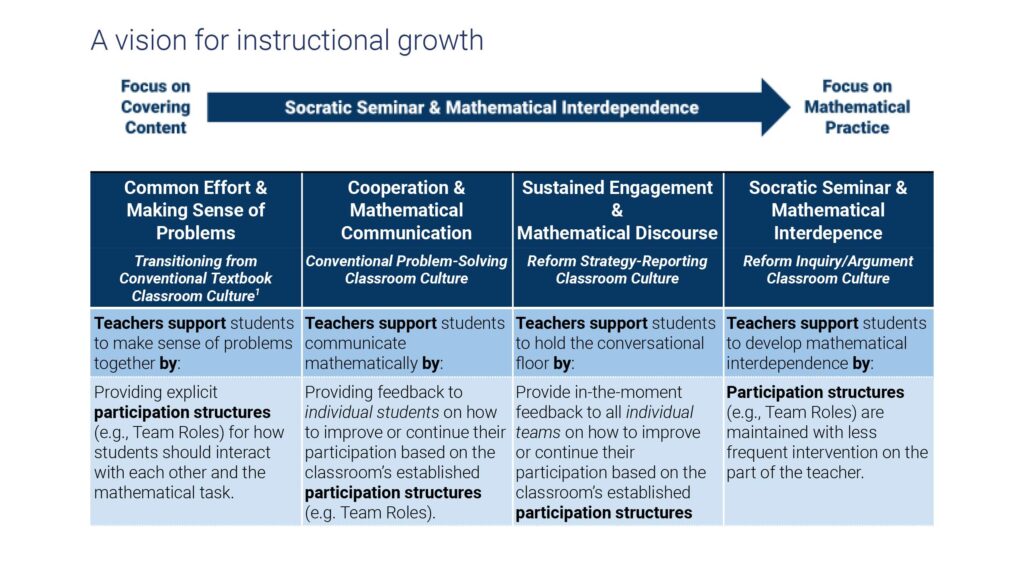May 2024

Several years ago, teachers started using a system where they would place a picture of a pineapple outside their door to indicate to other teachers that they could visit that classroom. The idea was that the lesson they were teaching was “interesting” and therefore other teachers could witness student engagement and learning—but most of all, effective teaching. An upgrade to this system evolved into “Pineapple Charts” which were essentially calendars posted in break rooms so that teachers could indicate which days or lessons would be valuable to watch. This system provides some very valuable professional learning because it gives teachers the permission they feel they need to collaborate with their colleagues about educational challenges. It also provides a safe way to observe each other and be reflective of their own practice, and it creates collective efficacy among teachers that is not limited to subject matter or departments.
However, CPM classrooms are often different from other classrooms. I remember visiting my first CPM classroom (I think it was 2007)—it seemed loud, chaotic, and puzzling. I wasn’t sure how the students were learning. It took me a while, but eventually, during that first visit, I recognized engagement, ownership of the learning, and a rich discussion about mathematics. I was suspicious that there was some type of acting going on, but the teacher assured me that I could come into that classroom at any time and see the same engagement and learning. In a sense, this teacher could have had a pineapple posted outside the classroom every class period. I haven’t met many CPM teachers who would not welcome a visitor into their classroom at any time. I think this is because CPM teachers are often confident with the system of learning that they have set up. Tools such as team roles and Study Team and Teaching Strategies, accompanied with engaging problem-based learning and mixed, spaced practice, allow CPM teachers to focus on facilitating quality collaboration without having to invent an engaging lesson. That engagement is built into the contexts of the problems. However, just as I had to acclimate to the culture of learning in that teacher’s classroom, other teachers will also be uncertain about what learning is going on in a CPM classroom.
Let’s face it: because a CPM teacher is not standing in front of a class, writing mathematics on the board, it can appear that the teacher is doing very little. But when a classroom is functioning at the highest level, the teacher is doing a great deal monitoring many discussions and posing questions to check for understanding or advance learning. It just looks different. The teacher has done extensive work to set up a powerful culture of learning. The question I ask myself is, “How can we set up a visiting teacher to recognize all that is happening in the CPM classroom?”
To answer this question, I first wondered how much CPM philosophy a visiting teacher has to know before understanding what is happening in the classroom.
- Do they have to understand why students are in teams?
- Do they have to understand how the problems that the students are tackling are organized to create a compelling story?
- Do they have to understand how often students are revisiting a topic?
These three questions are connected to CPM’s three pillars, and they are also questions focused on the teaching practice. These questions can be compelling for the CPM teacher after an observation to provide the storyline behind their current practice. However, a safer practice is to guide that visiting teacher toward what the students are doing and saying during the lesson rather than what the teacher is doing or saying. Ask the visiting teacher to focus on student actions and discussions. Ask that they make notes that can guide a discussion after the class has ended. This would build collaboration between the teachers to support each other with their practice.
CPM’s research base provides reports on the three pillars (Collaborative Learning, Problem-Based Learning, and Mixed, Spaced Practice), each with a table (a vision for instructional growth) at the bottom of the full report that can help you create those student-centered conversations. If visiting teachers had a copy of one of these tables, they would possess a way to understand what the CPM teacher is trying to accomplish in their classroom and a powerful conversation starter when the two teachers debrief.
How do you prepare yourself for those student-centered conversations with a visiting teacher? I recommend having a copy of one of the tables. During the class, write a timestamp and a quick note on the box representing the student actions you witness. Later, when debriefing with the visiting teacher, you can use this to support the conversation. I also recommend the visiting teacher only focus on the student shift table initially. The teacher shift table could be referenced when the teachers are debriefing afterward. With these tables as guides for conversation, the teacher visiting a CPM classroom will understand the culture the CPM teacher is trying to build and have an opportunity for meaningful reflection.
You do not have to wait until next school year to start a meaningful system of peer observation of CPM classrooms. You don’t even need a picture of a pineapple. Fasten a folder to your door containing several of the student shift tables. You get to choose which pillar you want the visiting teacher to see. You can still use the idea of a “Pineapple Chart” if you wish, but instead of selecting specific lessons, select a pillar you want to discuss during any particular day or week. There is no reason to dread a spontaneous visit to your classroom if you are providing the lens through which they will witness how your students are learning.



John Hayes
johnhayes@cpm.org

